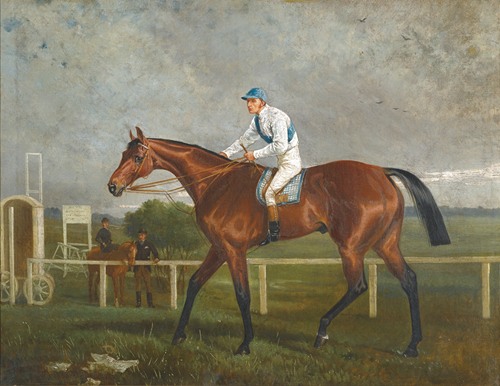Alfred Frank de Prades
Alfred Frank de Prades (signed works as A F de Prades) French painter working in Victorian England. An Animalier best known for his paintings of horses and military subjects, de Prades’ works follow very closely the tradition of George Stubbs (1724-1806) a style which popularized him among the noble British sporting set, who heavily patronized the artist from about 1850 until his death in 1885.
Alfred Frank de Prades (birth name: Anacharsis François Prestreau.) was born in Lunel, Hérault, France, the son of a Huguenot shipping magnate, Emile Jacob Pierre Marie Simon Alexandre Prades-Prestreau, (Genoa 1794-St Helier after 1879) and his wife Pascale Victoire Garnier. (Lunel, Hérault,1806--Meulan-en-Yvelines, 1875) Information on his life until the age of 25 or so is sparse, though it is clear that he was raised in England from the age of 16 when his father, Emile Prades-Prestreau abandoned his wife in Paris and reestablished himself in London, changing his name from Prestreau to Prades
It is not currently known where and with whom Frank trained as an artist, but he was painting equine subjects as young as the age of 13. A surviving canvas painted at this age, “Down the Stretch", is an early, naïf study executed in 1838 showing early interest in horses, racing and his instinctual command of equine anatomy.
A F de Prades was a regular participant in shows at the British Institution, a group of artists rebelling against the formalism of the Royal Academy of Arts. However de Prades was accepted to show in at least three major exhibitions with the Royal Academy of Arts beginning with a monumental scale painting in 1857 (Exhibit. No.1122) ”On the Heights near Boulogne, 8th September 1854: Present: HM the Emperor Louis-Napoléon,; HRH Prince Albert, KG; the Duke of Newcastle, Marshal Vaillant, General Lord Seaton, General Weatherall, Colonel Fleury, Colonel Daniell, the Baron de Bourgoing, Marquis de Soulongeon, General Gray, Colonel Biddulph, etc, etc...” and quite a few other notables on horseback--an engraving of which had also been reproduced in the Illustrated London News the year before). He continued to exhibit at the Royal Academy in 1861 and 1879, as well as at the Royal Society of British Artists and the Walker Art Gallery (Liverpool) . His publicly accessible work is held by the National Army Museum,(10 associated works) Walker Art Gallery, Bristol Museum and Art Gallery, and the Royal Collection, among others. King Edward VII commissioned a de Prades’ painting of his racehorse “Fairplay”, winner of the 1882 Household Brigade Cup at Sandown, further cementing his patronage by the bon ton of the United Kingdom. “Fairplay” is recorded as hanging in Buckingham Palace in 1909 and is still part of the Royal Collection.
Unmarried, Frank de Prades moved his lodgings around the Covent Garden area of London, but traveled a considerable amount as most of his paintings were commissions from the nobility to paint themselves and their horses, as well as military men who wanted to be painted on the field of their glory. Frank died suddenly as a result of a fall from a hansom cab, fracturing his skull, 7 July, 1885 at the age of 60 outside his home in London at 8 Southhampton Street, and is buried with his younger brother Henri and sister in law, Annie Boles de Prades in Kensal Green Cemetery, London.

